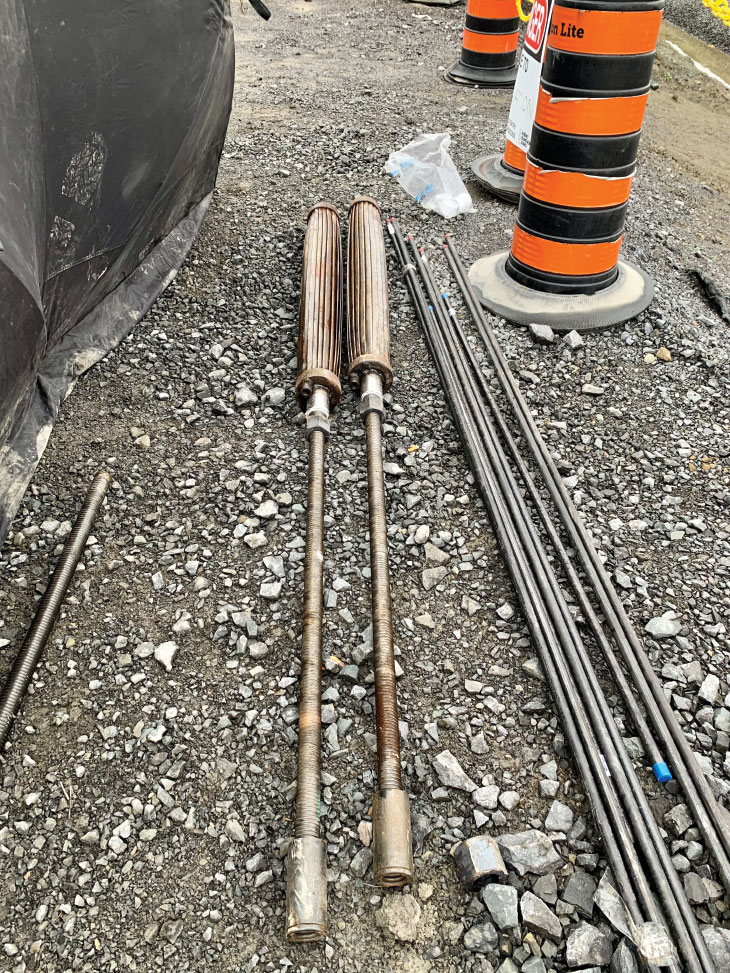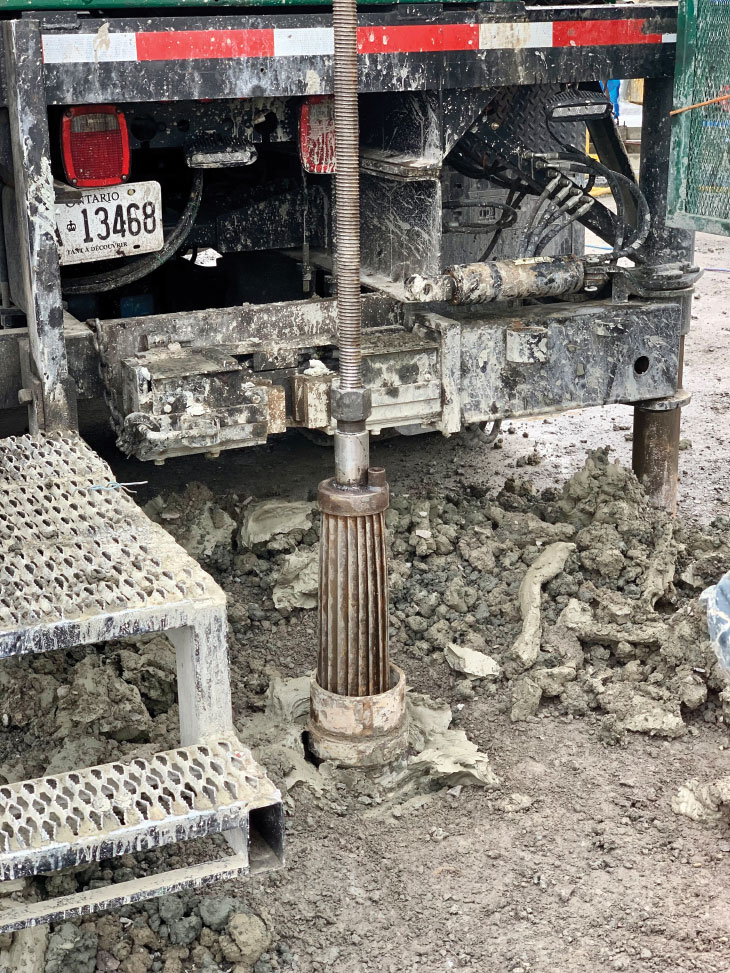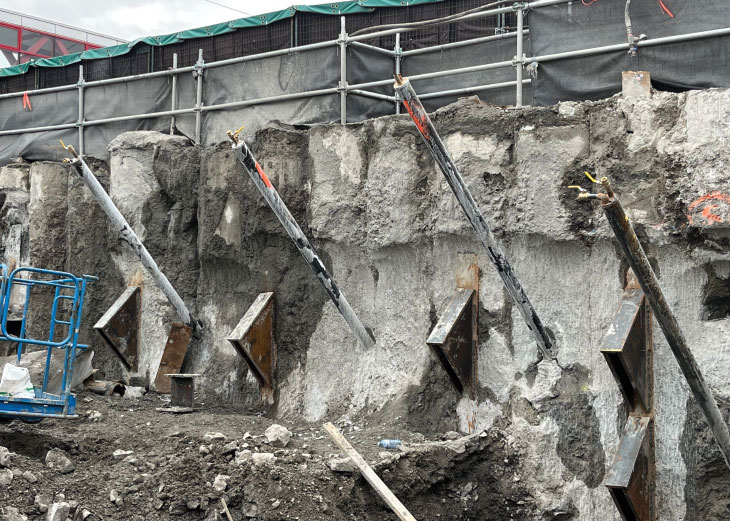
Reducing its carbon footprint has become a key objective for the construction industry as it looks to address climate change, promote sustainability and make more efficient use of resources. A pair of technologies offered by Ottawa-based Expander Body International (EBI) promise to do just that.
The first is the aptly name Expander Body unit, a pleated steel cylindrical body that is placed at the tip of a pile or tieback and is expanded by injecting cement grout under pressure. This expansion process generates a significant increase in the diameter of the unit (think of a Jiffy Pop popcorn maker). As a result, it compresses the earth around it to maximize the capacity of that pile or anchor.
The company’s other device is the Smart Cell grout injection system, designed to enhance the performance of drilled shafts by mobilizing both lateral and toe resistance during expansion. It attaches to the bottom of the reinforcing cage of drilled shafts and functions like a hydraulic jack. The Smart Cell expands during the injection process, which generates bi-directional force upwards against the shaft and downwards into the soil through the pile toe. This process pre-stresses the soil at the pile toe and increases the stiffness of the pile and its load-bearing capacity while also reducing settlement.
General manager and vice-president of business development Biff Heringer says the beauty of the two devices is that not only can they save foundation companies a substantial amount of time and money, but they also significantly reduce CO2 emissions.
The company estimates that their technologies can result in a reduction of as much as 65 per cent in concrete consumption and a similar decrease in the amount of steel required since the piles don’t need to be as wide in diameter or inserted as deeply into the ground. As a result, they also cut CO2 emissions by as much as half.


Since piles and tiebacks can be installed in much less time than using traditional installation methods, drilling rigs operate for a much shorter amount of time meaning far less exhaust emissions. The units can also produce a reduction of up to 90 per cent in the transportation of excavated soil for foundations, which translates into reduced exhaust emissions and fuel used to perform that task.
“If I’m drilling 31 metres for every pile or tieback, but I can shorten that to seven metres, you’re running your drill rig a third [as much]. You’re using less steel [and] you’re using less diameter because you’re using smaller pieces,” Heringer said. “You also require less personnel and you’re using smaller equipment. It is compounding itself over and over and over again. Not only are you going less deep (into the ground) and using less steel and not drilling as much, but those factors are also compounded throughout the whole foundation project.”
Another benefit of the two EBI devices is that there is little settlement compared to most traditional foundation piles. That’s because as the units are inflated beneath the pile, they pre-load the soil. Each Expander Body and Smart Cell unit provides real-time data, helping to mitigate risk and ensure outcomes on a pile’s behaviour below ground. This allows engineers to assess the pile’s response and verify that the resistance requirement has been achieved.
Each Expander Body and Smart Cell unit provides real-time data, helping to mitigate risk and ensure outcomes on a pile’s behaviour below ground.
The current expansion of the Ottawa Light Rail Transit system, or O-Train, is an example of the effectiveness of the Expander Body unit, which can be used to build piles and tiebacks at any incline angle, even upside down. EBI was called in to assist with the project when crews were having difficulty achieving the required 1,000 kilonewtons (kN) of capacity required per tieback. Not only did the Expander Body unit more than double the amount of tieback resistance from just over 600 kN to 1,200 kN, but it also helped reduce the required drilling depth from 31 metres to seven. “They were just floored,” Heringer said of the reaction of officials.
Another example of the Expander Body’s effectiveness was a viaduct project the company worked on in South America. The original design called for 731 piles. That number was reduced to 256 with the use of the Expander Body units. It was also able to increase the bearing capacity per pile from 420 to 1,300 kN. The company also reduced the time required to complete the project from 2,200 hours to just 820.
The Expander Body was first conceived in Sweden back in the 1980s. EBI tweaked the technology behind it over the years, thanks in part to the work of Mario Terceros and Bengt H. Fellenius, Dr.Tech., P.Eng., professors and geotechnical experts who sit on the company’s board of directors. To date, the Expander Body and Smart Cell have been used in a total of 362 projects in 16 countries including here in North America and as far away as Bolivia. In addition to cutting CO2 emissions on those projects by about 50 per cent, the two products helped save more than 40,000 labour hours or the equivalent of 650 work weeks.
One of the early challenges the EBI team had to address was how companies could use the units without having to change their traditional workflow and utilize the equipment they already had on hand. Mission achieved, says Heringer. “It wasn’t going to be effective or adoptable unless it was easy for them to use. Companies don’t want to have to go out and buy a new million dollar rig. They don’t want to have to go out and get anything new,” he said. “It can work with everything they currently have or the normal equipment they have and it’s easy to understand. The learning curve for the Expander Body for installers is literally one day. For engineers to design with it, it may take a bit longer.”

To assist companies unfamiliar with the Expander Body and Smart Cell, EBI provides onsite training to users, and the company remains onsite for as long as a client requires. In some cases, the company also vets project designs until the users are comfortable using the technology. EBI worked with developers, engineering firms and installers to come up with the latest iteration of the Expander Body. While capacity, risk and time/cost savings were common concerns the company heard, Heringer says most of those companies identified reducing their carbon footprint as an emerging issue that needed to be addressed.
“We looked at the industry and said, how can EBI help to maximize the efficiency of what they’re trying to do,” he said. “What we did was we went back to the drawing board and tried to look at ways to improve those efficiencies. We looked at all the parameters that were involved and then tried to maximize each area: capacity, risk, cost and the environment.”
The Expander Body can be used in virtually any kind of soil from soft or loose to very dense. Where shallow rock is present, the Expander Body becomes less advantageous financially. The bi-directional Smart Cell is particularly suited for large-diameter applications but can even be used in micropiles.
Heringer says EBI has invested considerable time and effort into educating clients about their two products. To that end, the company is trying to be proactive, and staff regularly speak to third and fourth-year engineering students about their products and how they can be used most effectively. “The earlier we put this in their toolbox, the more common it becomes and the more accepted it becomes,” Heringer said.